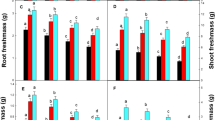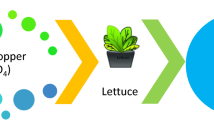Abstract
Changes in ascorbic acid content and antioxidant enzyme activities were investigated in non-heading Chinese cabbage (Brassica campestris ssp. chinensis Makino) leaves of ‘Wutacai’ and ‘Erqing’ exposed to excess copper (Cu). Cu treatment reduced the fresh weight of shoot and root by 57% and 46% in ‘Wutacai’, and 60 and 54% in ‘Erqing’, respectively. The accumulation of copper in leaves was higher in ‘Wutacai’ than that in ‘Erqing’. Compared to the control, ascorbic acid (AsA) contents were significantly decreased after copper treatment in both cultivars, while they were higher in ‘Wutacai’ than in ‘Erqing’, which may explain the higher copper-tolerance of ‘Wutacai’ with higher copper accumulation. The higher AsA contents of ‘Wutacai’ resulted from their lower activities of degrading enzymes, such as ascorbate oxydase (AAO) and ascorbate peroxidase (APX), as well as the increasing activity of dehydroascorbate reductase (DHAR) after copper treatment compared with ‘Erqing’. Copper stimulated superoxide dismutase (SOD) activity in both cultivars, but for catalase (CAT), there was little difference between both cultivars. Peroxidases (POD) activity was decreased after copper treatment in ‘Erqing’, while in ‘Wutacai’, it was significantly increased at 14 days, and POD activity was higher in ‘Wutacai’ than that in ‘Erqing’ at 21 and 28 days. Therefore, the induced increasing activity of POD in ‘Wutacai’ also played an important role in its copper tolerance.





Similar content being viewed by others
References
Abassi NA, Kushad MM, Endress AG (1998) Active oxygen scavenging enzymes activities in developing apple flowers and fruits. Sci Hortic (Amsterdam) 74:183–184. doi:10.1016/S0304-4238(98)00077-6
Alaoui-Sossé B, Genet P, Vinit-Dunand F, Toussaint ML, Epron D, Badot PM (2004) Effect of copper on growth in cucumber plants (Cucumis sativus) and its relationships with carbohydrate accumulation and changes in ion contents. Plant Sci 166:1213–1218. doi:10.1016/j.plantsci.2003.12.032
An HM, Chen LG, Fan WG, Liu QL (2005) Relationship between ascorbic acid and related enzyme activities in fruit of Rosa roxburghii Tratt. J Plant Physio Mol Biol 31(4):431–436
Angelini R, Frederico R (1989) Histochemical evidence of polyamine oxidation and generation of hydrogen peroxide in the cell wall. J Plant Physiol 135:212–217
Arakawa N, Tsutsumi K, Sanceda NG, Kurata T, Inagaki C (1981) A rapid and sensitive method for the determination of ascorbic acid using 4, 7-diphenyl-1, 10-phenanthroline. Agric Biol Chem 45(5):1289–1290
Asada K (1992) Ascorbate peroxidase—a hydrogen peroxide-scavenging enzyme in plants. Physiol Plant 85:235–241. doi:10.1111/j.1399-3054.1992.tb04728.x
Babu TS, Marder JB, Tripiranthakam S, Dixon DG, Greenberg BM (2001) Synergistic effects of a photooxidized polycyclic aromatic hydrocarbon and copper on photosynthesis and plant growth: evidence that in vivo formation of reactive oxygen species is a mechanism of copper toxicity. Environ Toxicol Chem 20:1351–1358. doi :10.1897/1551-5028(2001)020<1351:SEOAPP>2.0.CO;2
Bowler C, Montagu MV, Inze D (1992) Superoxide dismutase and stress tolerance. Annu Rev Plant Physiol 43:83–116. doi:10.1146/annurev.pp.43.060192.000503
Cakmak I, Marschner H (1992) Magnesium deficiency and high light intensity enhance activities of superoxide dismutase, ascorbate peroxidase and glutathione reductase in bean leaves. Plant Physiol 98:1222–1227
Chance B, Sies H, Boveris A (1979) Hydroperoxide metabolism in mammalian organs. Physiol Rev 59:527–605
Chaoui A, Ferjani EE (2005) Effects of cadmium and copper on antioxidant capacities, lignification and auxin degradation in leaves of pea (Pisum sativum L.) seedlings. C R Biologies 328:23–31. doi:10.1016/j.crvi.2004.10.001
Chen Z, Young TE, Ling J, Chang SC, Gallie DR (2003) Increasing vitamin C content of plants through enhanced ascorbate recycling. Proc Natl Acad Sci USA 100:3525–3530. doi:10.1073/pnas.0635176100
Demirevska-Kepova K, Simova-Stoilova L, Stoyanova Z, Hölzer R, Feller U (2004) Biochemical changes in barley plants after excessive supply of copper and manganese. Environ Exp Bot 52:253–266. doi:10.1016/j.envexpbot.2004.02.004
Detullio MC, Liso R, Arrigoni O (2004) Ascorbic acid oxidase: an enzyme in search of a role. Biol Plant 48(2):161–166. doi:10.1023/B:BIOP.0000033439.34635.a6
Fernando CL, Henrques FS (1992) Copper toxicity in rice: diagnositic criteria and effect on tissue Mn and Fe. Soil Sci 154(2):130–135
Foyer CH, Looez-Delgado H, Dat JF, Scott IM (1997) Hydrogen peroxide and glutathione-associated mechanisms of acclamatory stress tolerance and signaling. Physiol Plant 100:241–254. doi:10.1111/j.1399-3054.1997.tb04780.x
Guo SR (2003) Soilless cultivation science. China Agricultural Press, Beijing, pp 111–115
Kumar GNM, Knowles NR (1993) Changes in lipid peroxidation and lipolytic and free-radical scavenging enzyme activities during aging and sprouting of potato (Solanum tuberosum) seedtubers. Plant Physiol 102:115–124
Li M, Hu CW, Zhu Q, Chen L, Kong ZM, Liu ZL (2006) Copper and zinc induction of lipid peroxidation and effects on antioxidant enzyme activities in the microalga Pavlova viridis (Prymnesiophyceae). Chemosphere 62:565–572. doi:10.1016/j.chemosphere.2005.06.029
Lidon FC, Henriques FS (1992) Copper toxicity in rice: diagnositic criteria and effect on tissue Mn and Fe. Soil Sci 154(2):130–1351. doi:10.1097/00010694-199208000-00006
Lombardi L, Sebastiani L (2005) Copper toxicity in Prunus cerasifera: growth and antioxidant enzymes responses of in vitro grown plants. Plant Sci 168:797–802. doi:10.1016/j.plantsci.2004.10.012
Lönnerdal B (1998) Copper nutrition during infancy and childhood. Am J Clin Nutr 67:1046–1053
Mazhoudi S, Chaoui A, Ghorbal MH, Ferjani EE (1997) Response of antioxidant enzymes to excess copper in tomato (Lycopersicon esculentum, Mill.). Plant Sci 127:129–137. doi:10.1016/S0168-9452(97)00116-7
Monnet F, Bordas F, Deluchat V, Baudu M (2006) Toxicity of copper excess on the lichen Dermatocarpon luridum: antioxidant enzyme activities. Chemosphere 65:1806–1813. doi:10.1016/j.chemosphere.2006.04.022
Morelli E, Scarano G (2004) Copper-induced changes of non-protein thiols and antioxidant enzymes in the marine microalga Phaeodactylum tricornutum. Plant Sci 167:289–296. doi:10.1016/j.plantsci.2004.04.001
Nickel RS, Cunningham BA (1969) Improved peroxidase assay method using Ieuco 2, 3, 6-trichlcroindophenol and application to comparative measurements of peroxidase catalysis. Ann Biochem 27:292–299. doi:10.1016/0003-2697(69)90035-9
Noctor G, Foyer CH (1998) Ascorbate and glutathione: keeping active oxygen under control. Annu Rev Plant Physiol Plant Mol Biol 49:249–279. doi:10.1146/annurev.arplant.49.1.249
Oberbacher MF, Vines HM (1963) Spectrophotometric assay of ascorbic acid oxidase. Nature 197:1203–1204. doi:10.1038/1971203a0
Padh H (1990) Cellular functions of ascorbic acid. Biochem Cell Biol 68:1166–1173
Palma JM, Gómez M, Yáńez J, Del Río LA (1987) Increased levels of peroxisomal active oxygen-related enzymes in copper-tolerant pea plants. Plant Physiol 85:570–574
Pastori GM, Kiddle G, Antoniw J, Bernard S, Veljovic-Jovanovic S, Verrier PJ et al (2003) Leaf vitamin C contents modulate plant defense transcripts and regulate genes that control development through hormone signaling. Plant Cell 15:939–951. doi:10.1105/tpc.010538
Rama DS, Prasad MNV (1998) Copper toxicity in Ceratophyllum demersum L. (Coontail), a free floating macrophyte: response of antioxidant enzymes and antioxidants. Plant Sci 138(2):157–165. doi:10.1016/S0168-9452(98)00161-7
Rao KVM, Sresty TVS (2000) Antioxidant parameters in the seedlings of pigeon pea (Cajanus cajan L. Millspaugh) in response to Zn and Ni stresses. Plant Sci 157:113–128. doi:10.1016/S0168-9452(00)00273-9
Rouso PA, Harrison HC (1987) Identification of differential responses of cabbage cultivars to copper toxicity in solution culture. J Am Soc Hortic Sci 12(6):928–931
Scheinfeld N, Dahdah MJ, Scher R (2007) Vitamins and minerals: their role in nail health and disease. J Drugs Dermatol 6(8):782–787
Schützendübel A, Polle A (2002) Plant responses to abiotic stresses: heavy metal-induced oxidative stress and protection by mycorrhization. J Exp Bot 53:1351–1365. doi:10.1093/jexbot/53.372.1351
Smirnoff N, Conklin PL, Loewus FA (2001) Biosynthesis of ascorbic acid in plants: a renaissance. Annu Rev Plant Physiol Plant Mol Biol 52:437–467. doi:10.1146/annurev.arplant.52.1.437
Srivastava S, Mishra S, Tripathi RD, Dwivedi S, Gupta DK (2006) Copper-induced oxidative stress and responses of antioxidants and phytochelatins in Hydrilla verticillata (L.f.) Royle. Aquat Toxicol 80:405–415. doi:10.1016/j.aquatox.2006.10.006
Stasolla C, Yeung EC (2001) Ascorbic acid metabolism during white spruce somatic embryo maturation and germination. Physiol Plant 111:196–205. doi:10.1034/j.1399-3054.2001.1110210.x
Tabata K, Obak Suzuki K, Esaka M (2001) Generation and properties of ascorbic acid-deficient transgenic tobacco cells expressing antisense RNA for L-galactono-1, 4-lactone dehydrogenase. Plant J 27(2):139–148. doi:10.1046/j.1365-313x.2001.01074.x
Takahashi MA, Asada K (1983) Superoxide anion permeability of phospholipid membranes and chloroplast thylakoids. Arch Biochem Biophys 226:558–566. doi:10.1016/0003-9861(83)90325-9
Teisseire H, Guy V (2000) Copper-induced changes in antioxidant enzymes activities in fronds of duckweed (Lemna minor). Plant Sci 153:65–72. doi:10.1016/S0168-9452(99)00257-5
Valpuesta V, Botella MA (2004) Biosynthesis of L-ascorbic acid in plants: new pathways for an old antioxidant. Trends Plant Sci 9:573–577. doi:10.1016/j.tplants.2004.10.002
Washko PW, Welch RW, Dhariwal KR, Wang Y, Levine M (1992) Ascorbic acid and dehydroascorbic acid analyses in biological samples. Anal Biochem 204:1–14. doi:10.1016/0003-2697(92)90131-P
Zhang YP, Zhang YL, Zhou YH, Yu JQ (2007) Adaptation of cucurbit species to changes in substrate temperature: root growth, antioxidants, and peroxidation. J Plant Biol 50(5):527–532
Acknowledgment
This work was supported by the National Natural Science Foundation of China (30500343).
Author information
Authors and Affiliations
Corresponding author
Additional information
Communicated by G. Bartosz.
Rights and permissions
About this article
Cite this article
Li, Y., Song, Y., Shi, G. et al. Response of antioxidant activity to excess copper in two cultivars of Brassica campestris ssp. chinensis Makino. Acta Physiol Plant 31, 155–162 (2009). https://doi.org/10.1007/s11738-008-0216-9
Received:
Revised:
Accepted:
Published:
Issue Date:
DOI: https://doi.org/10.1007/s11738-008-0216-9




